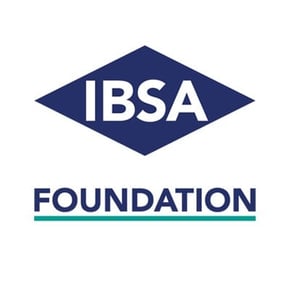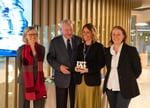For the tenth edition of the Fellowship program, IBSA Foundation offered 6 fellowships of €30,000 each in the following research fields: dermatology, endocrinology, fertility/urology, pain medicine/orthopaedics/rheumatology and two for the special edition 2022 "Healthy Aging".
The 2022 edition had a record number of projects received. A total of 211 applicants participated, including 129 women and 82 men, from 29 different countries.
The Award Ceremony took place on 20 April in Lugano, at the IBSA cosmos plant.
A consegnare le borse di studio sono stati Arturo Licenziati, Presidente e CEO del Gruppo IBSA, Silvia Misiti, Direttore di IBSA Foundation per la ricerca scientifica e Luisa Lambertini, Rettrice nominata dell’Università della Svizzera italiana.
At the award ceremony, the scholarships were presented by Arturo Licenziati, President and CEO of IBSA Group, Silvia Misiti, Director of IBSA Foundation for scientific research, and Luisa Lambertini, Appointed Rector of the Università della Svizzera italiana.
At the award ceremony, the scholarships were presented by Arturo Licenziati, President and CEO of IBSA Group, Silvia Misiti, Director of IBSA Foundation for scientific research, and Luisa Lambertini, Appointed Rector of the Università della Svizzera italiana.
“Supporting cutting-edge research and projects to advance society and open up new avenues of scientific research: this is the goal we aim to achieve by renewing the call for the Fellowship programme every year” – explains Silvia Misiti, Director of IBSA Foundation – “We have been pursuing this commitment for 10 years now and we will continue to do so, because we believe in the talent of today's young researchers, in helping them become the scientists of tomorrow”.
Below you can find the names of the six winners and the title of their works:
Winners
Dermatology: Laura Yerly
Department of Dermatology and Venereology, Hôpital de Beaumont, Lausanne University Hospital Center, 1011 (Switzerland)
Project Title: Dissecting the cellular and molecular interactions governing perineural invasion in cutaneous squamous cell carcinoma patients to identify novel therapeutic strategies.
Cutaneous squamous cell carcinoma (cSCC) is the second most common skin cancer. cSCC is commonly cured by surgery, but some tumors metastasize. To disseminate, cSCC uses well-known dissemination routes, among which is the spreading along nerve structures, called “perineural invasion” (PNI). PNI is poorly investigated, but clinically challenging as it is associated with higher local recurrence rates and reduced survival. In this project, we aim to infer, from transcriptional reprogramming, the cellular and molecular interactors governing PNI in human cSCCs and thus identify potential therapeutic targets. To this end, we plan to perform spatial transcriptomic analysis using GeoMx digital spatial profiling on human cSCC samples with clinically relevant PNI to define spatially-resolved transcriptional reprogramming underlying PNI and extract PNI-specific gene signatures. Nevertheless, current spatial transcriptomic does not offer whole transcriptome sequencing at a single cell level. Thus, we plan to run single cell RNA sequencing (scRNAseq) on human cSCC samples with clinically relevant PNI in parallel. Then, as spatial transcriptomic lacks single cell resolution and scRNAseq lacks spatial information, we plan to integrate both techniques by applying spatial signatures on scRNAseq data to deconvolute the cell types contributing to PNI and to evaluate which cells are spatially-connected. Finally, we plan to take advantage of existing interaction algorithms to identify candidate genes implicated in paracrine signaling of spatially-connected cells, which might serve as therapeutic target against PNI.
Endocrinology: Camilla Basso
Laboratory for Surgical Translational Research, Department of Surgery, Ente Ospedaliero Cantonale and Faculty of Biomedical Science, Università della Svizzera italiana (Switzerland)
Project Title: Fat-infiltrating microbiota: a new player in obesity?
The obesity epidemic has now become a leading cause of morbidity and mortality in the developed world. Bariatric surgery represents the most efficient solution for the treatment of severely obese patients. Yet, a considerable percentage of patients regain weight within two years after surgery. Factors influencing treatment outcomes are still controversial and emerging evidence suggests a possible role of the gut microbiota. Notably, obesity is associated with an increased gut mucosal permeability, a condition allowing the translocation of gut microbiota from the lumen into the visceral adipose tissue (VAT). However, the actual occurrence of such translocation and its possible impact on obesity progression and the long-term outcome of surgical treatment has not been investigated so far. Importantly, the VAT of obese patients is infiltrated by activated immune cells, leading to a low-grade systemic inflammation contributing to obesity development and its associated complications. Factors triggering immune cell functions in the VAT have not been evaluated yet. In preliminary studies, we detected the presence of bacteria in the VAT of obese patients undergoing bariatric surgery and the expression of bacteria-sensing receptors on VAT-infiltrating cells. In addition, a preliminary characterization of VAT-infiltrating immune cells revealed a pro-inflammatory phenotype as compared to immune cell populations in corresponding subcutaneous fat tissues. We hypothesize that the VAT of obese patients is populated by a specific microbiota, triggering the activation of VAT-infiltrating immune cells and inducing systemic chronic inflammation, which impacts the development of obesity and bariatric surgery outcome. Successful implementation of this project will help to clarify mechanisms associated with the clinical course of the disease and will provide novel insights for the development of innovative treatments based on visceral fat-infiltrating microbiota (vFIM) modulation.
Fertility/Urology: Valentina Lorenzi
European Molecular Biology Laboratory - European Bioinformatics Institute, Wellcome Sanger Institute, University of Cambridge (UK)
Project Title: Unraveling the temporal and spatial dynamics of the developing human reproductive ducts
With this study, I want to harness the power of single-cell genomics technologies to create the first spatiotemporal map of human Müllerian and Wolffian duct development and differentiation during the initial two trimesters of gestation. Using a combination of single-cell transcriptomics and chromatin accessibility sequencing, I aim to characterise for the first time the diversity of cell states present in the reproductive tracts along the course of development. This unbiased and comprehensive approach will make it possible to pinpoint the gene regulatory networks that underlie the emergence, differentiation and regression of the reproductive ducts. In addition to temporal development, I also plan to investigate the spatial cranio-caudal developmental axis moving along the ducts away from the gonads towards the urogenital sinus. The spatial axis is extremely relevant in assessing the influence of hormones secreted by the gonads as well as the paracrine cellular interactions occurring within the different regional niches of the ducts [1]. To examine such regional differences along the spatial cranio-caudal axis, I aim to complement the single-cell profiling with in situ sequencing and spatial transcriptomics measurements. As these technologies capture mRNAs directly on the tissue slice, I will be able to correlate histological and morphological features with gene expression changes. More specifically, I am interested in investigating how cell type abundances and gene expression within each cell type change along the cranio-caudal axis of development. The ultimate goal of the project is to computationally integrate all data modalities into a coherent single-cell and spatially-resolved molecular map of the development of the human reproductive tracts with a view to improve our understanding of developmental abnormalities and other reproductive disorders, including infertility.
Pain medicine / Orthopaedics / Rheumatology: Francesco De Logu
Università degli Studi di Firenze, Dipartimento di Scienze della Salute, Laboratorio di Farmacologia Clinica e Oncologia Sperimentale (Italy)
Project Title: tArgeted iNhibition of SChwann cell HORmone pAthway in GendEr pain (ANCHORAGE)
Chronic pain, characterized by increased sensitivity to harmless/mild stimuli, is a distressing condition affecting more than 10% of the population worldwide. Women are more frequently affected by chronic pain conditions, such as migraine, fibromyalgia, and arthritis, and they suffer from gender specific pain conditions, including endometriosis and dysmenorrhea. The identification of the sex-specific pain signatures is of paramount importance for the discovery of new targets for better and safer analgesic treatments for women. The contribution of glial cells of the central nervous system to chronic pain has been extensively investigated. However, although chronic pain generally initiates in the periphery, much less effort has been dedicated to investigating the role of peripheral glial cells, including Schwann cells (SCs). We recently revealed that SCs sense oxidative stress and modulate neuroinflammation via their own repertoire of receptors/channels, including the transient receptor potential ankyrin 1 (TRPA1), thereby sustaining chronic pain. Via this pathway, SCs play a critical role in several models of chronic pain, including nerve trauma, ischemia/reperfusion, polyneuropathy, cancer and migraine. Our preliminary data in mice show that Schwann cell TRPA1 plays an essential role in the periorbital mechanical allodynia (a mouse model of migraine) elicited by local/systemic estradiol. By adeno associated viral (AAV) vectors for cell-specific silencing of hormone/TRPA1 pathway in SCs and neurons, this project aims to identify how estrogens regulate the proalgesic action of SCs and neurons via TRPA1, and the role of the estrogen-TRPA1-SC pathway in mouse models of diseases with high female prevalence (migraine) or that affect only women (endometriosis). We anticipate that this project will disclose the molecular estrogen-dependent gender signature in SCs and provide innovative strategies for treatment of gender-related painful conditions.
1st Winner - Healthy Aging: Marco Fantuz
Fondazione Ricerca Biomedica Avanzata VIMM; Dipartimento di Biologia, Università degli Studi di Padova (Italy)
Project Title: Can impairments of mitochondria-to-nucleus communication explain age-associated decline of humoral immunity?
Functional specification of B lymphocytes is supported by metabolic and epigenetic reprogramming, but both are dysfunctional in aging. Elderly individuals fail to mount an efficient humoral immunity, making them susceptible to severe infections; I hypothesize that metabolic-dependent epigenetic dysregulation hampers B cell maturation. Compelling work shows that metabolic rewiring has downstream effects on chromatin landscape. Acetyl-CoA is a pivotal metabolite compartmentalized in mitochondrial and nucleo-cytoplasmic pools. The latter is predominantly generated by ATP-Citrate Lyase (ACLY). Preliminary data indicate that ACLY is phosphorylated (activated) upon B cell stimulation. In accord, stimulated B cells exhibit histone hyperacetylation, while genetic ablation of ACLY suppresses B cell specification into antibody-producing cells. Interestingly, both ACLY phosphorylation and histone acetylation are attenuated in reactive B cells at human and mice lymphoid organs, suggesting the possibility that acetyl-CoA metabolism might be downregulated in aging, leading to degeneration of epigenetic control over gene expression. To test this possibility, I will interrogate nucleo-cytoplasmic acetyl-CoA availability in young or aged B cells using innovative technologies for the quantification of labile metabolites at subcellular resolution. Its distribution across multiple organelles will be examined, in keeping with reports suggesting that aging alters acetyl-CoA compartmentalization. I will also document the impact of acetyl-CoA rewiring on the epigenome. To this aim, I will apply state-of-the-art epigenetic profiling for low-input samples. This will define chromatin regions that are sensitive to metabolic perturbations. Their role for B cell specification will be directly examined. The project will dissect metabolism-chromatin signaling axis with the goal to identify molecular mechanisms that might enhance humoral immunity in the elderly.
2nd Winner - Healthy Aging: Julio Aguado
Australian Institute for Bioengineering and Nanotechnology AIBN, The University of Queensland (Australia)
Project Title: Pharmacological targeting of SARS-CoV-2 neuroinvasion and its long-term effect in healthy brain aging
Although SARS-CoV-2 is primarily a respiratory viral pathogen and the cause of coronavirus disease 2019 (COVID-19); persistent post-acute infection syndromes derived from viral infections including SARS-CoV-2 are emerging as a frequent clinical picture. These long-term consequences of recurrent viral infections are hypothesised to accelerate the aging process with direct consequences in shortening our healthspan. In fact, most COVID-19 patients including individuals with or without comorbidities, even asymptomatic patients, have consistently experienced a number of neurological complications. The so-called “long-COVID” is now gaining significant awareness, with patients reporting persistent manifestations, such as hyposmia, sleep disorders and substantial cognitive impairment, the latter affecting approximately one in four COVID-19 cases. These clinical symptoms are supported by increasing evidence of SARS-CoV-2 infectivity in multiple cell types of the nervous system, as well as important structural changes in the brains of COVID-19 patients. Furthermore, recent patient data indicate associations between the cognitive decline observed in patients with severe COVID-19 and molecular signatures of brain aging. Indeed, SARS-CoV-2 infection causes the generation of senescent cells, known drivers of neurodegenerative conditions and important contributors of human aging. In the past decade, numerous therapeutic strategies have been developed to target senescent cells. Among these, the pharmacological elimination of senescent cells via use of senolytic drugs has become one of the most explored interventions, with many currently in human clinical trials. This project will use human brain organoids and mouse models of COVID-19 disease to evaluate multiple novel senolytic drugs designed to selectively eliminate SARS-CoV-2-induced senescent cells that drive chronic inflammation and brain neurodegeneration, with the ultimate purpose of elongating healthy brain aging.

















